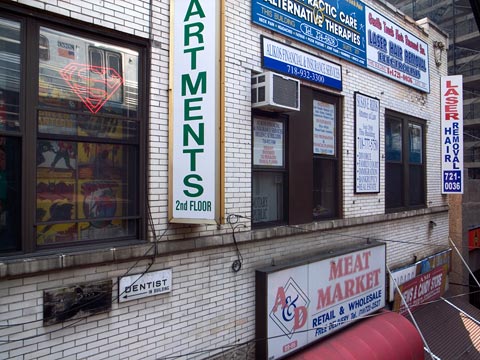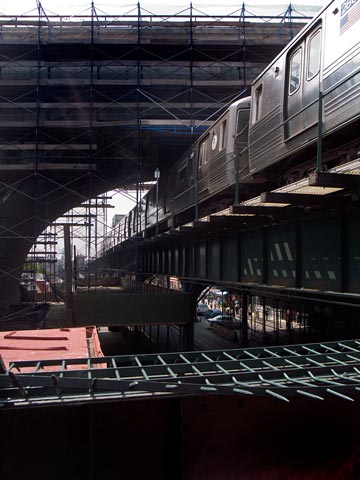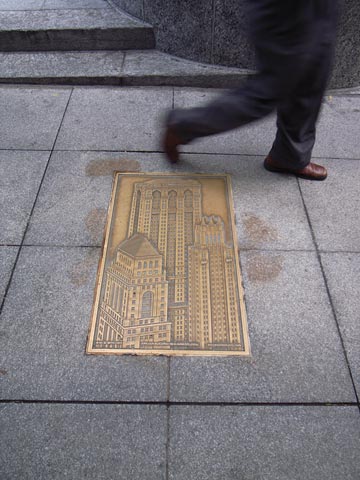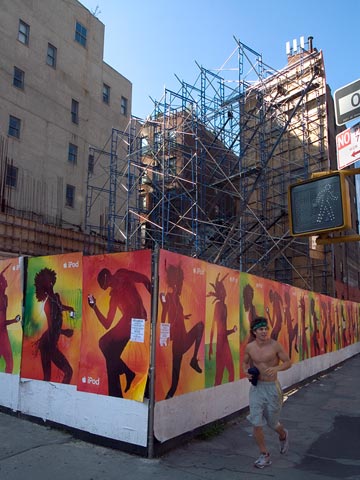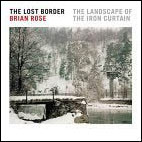Friday, August 31, 2007
Thursday, August 30, 2007
Wednesday, August 29, 2007
Monday, August 27, 2007
New York/LES
Saturday and Sunday evenings I got out with the view camera on the Lower East Side. I worked into dark on Saturday taking a picture of the Blue Condo above the Essex Market against a bluish sky with a rising moon. On Ludlow I photographed a tenement building with a ground floor bar opened on the street. A poetry reading in a bookstore/cafe on Allen Street. A restaurant on Clinton Street. An open door with pool table in a bar on Houston. Last, the entrance to Katz's Delicatessen with a saxophone player on the sidewalk. It's difficult to know how any of these are going to come out. All were time exposures with people swirling around, and cars blurring through.

Self-portrait with view camera, Houston Street and Second Avenue
Sunday, I began earlier with late afternoon sun still streaking between buildings and down streets. I decided to head for the Charlie Parker Jazz Festival taking place in Tompkins Square Park. Along the way I noticed the Polish 9/11 memorial in front of a church on East 7th Street. One of the more mawkish of such memorials.
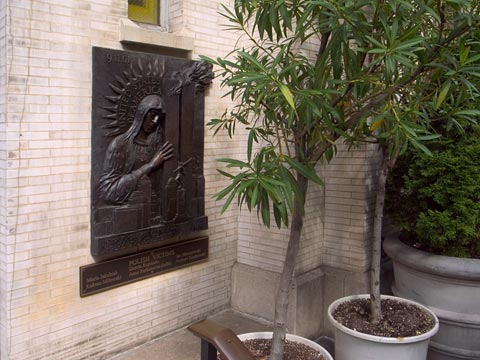
Polish 9/11 Memorial, East 7th Street
In the park there were at least a couple of thousand people seated or standing in front of the stage as well as many who had spread out over the lawn further back. I did several photographs of the crowd, one looking toward the stage, two others of people arrayed on the grass between the trees. The music was great, and I listened for a while.
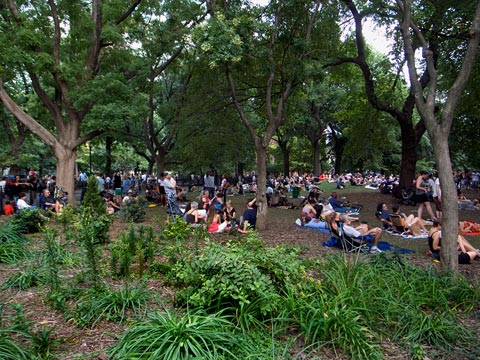
Tompkins Square Park, Charlie Parker Jazz Festival
Heading east I came across the 6 BC Garden, one of the most cultivated of the community gardens on the Lower East Side. It's a quite a bit more designed than the others with pools, architectural structures, and well-tended paths. The tenements enclose the space all around.
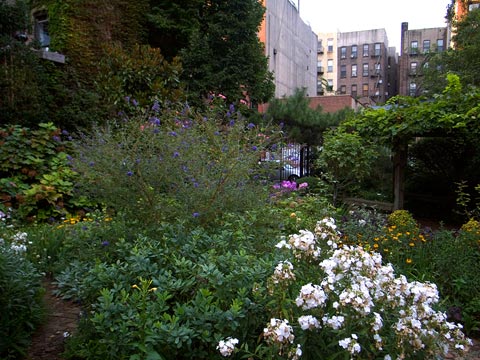
6 BC Garden, East 6th Street
Further east I did several pictures on or near Avenue C. Murals by Chico are everywhere in this area.

Just off Avenue C

East 7th Street and Avenue C
I ended up on East 7th Street between C and D. This block was always one of the best maintained in what was once referred to as the war zone. Strong tenant organization and co-op ownership kept the buildings occupied during that period when everything around was burning or being abandoned. Now, the Flower Box Building, with loft-style apartments costing well over a million dollars, is coming to completion on what was one of the few empty lots on the block.
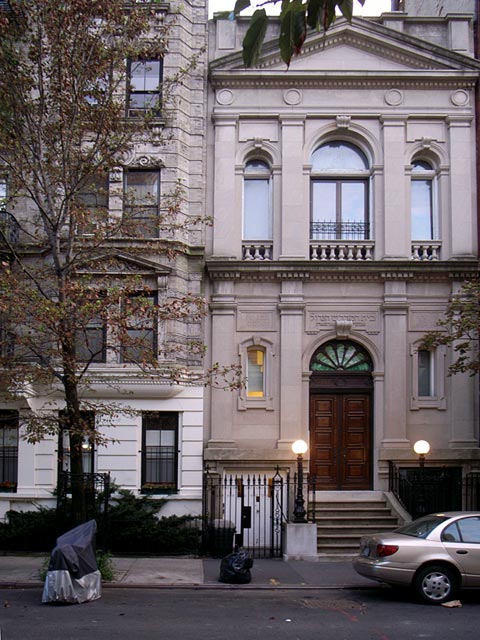
East 7th Street between C and D
I made a photograph of a series of stoops with decorative railings. Another of one of the housing project towers on Avenue D, and at dusk–heading back west–a synagogue and adjacent tenement.

Self-portrait with view camera, Houston Street and Second Avenue
Sunday, I began earlier with late afternoon sun still streaking between buildings and down streets. I decided to head for the Charlie Parker Jazz Festival taking place in Tompkins Square Park. Along the way I noticed the Polish 9/11 memorial in front of a church on East 7th Street. One of the more mawkish of such memorials.

Polish 9/11 Memorial, East 7th Street
In the park there were at least a couple of thousand people seated or standing in front of the stage as well as many who had spread out over the lawn further back. I did several photographs of the crowd, one looking toward the stage, two others of people arrayed on the grass between the trees. The music was great, and I listened for a while.

Tompkins Square Park, Charlie Parker Jazz Festival
Heading east I came across the 6 BC Garden, one of the most cultivated of the community gardens on the Lower East Side. It's a quite a bit more designed than the others with pools, architectural structures, and well-tended paths. The tenements enclose the space all around.

6 BC Garden, East 6th Street
Further east I did several pictures on or near Avenue C. Murals by Chico are everywhere in this area.

Just off Avenue C

East 7th Street and Avenue C
I ended up on East 7th Street between C and D. This block was always one of the best maintained in what was once referred to as the war zone. Strong tenant organization and co-op ownership kept the buildings occupied during that period when everything around was burning or being abandoned. Now, the Flower Box Building, with loft-style apartments costing well over a million dollars, is coming to completion on what was one of the few empty lots on the block.

East 7th Street between C and D
I made a photograph of a series of stoops with decorative railings. Another of one of the housing project towers on Avenue D, and at dusk–heading back west–a synagogue and adjacent tenement.
Saturday, August 25, 2007
New York/Around Town
West 32nd Street
Click here for larger rollover version
Having finished shooting and printing the Civil War monuments project, I am now back to the 39 buildings I was photographing a few weeks ago. Actually, the 39 are done, but I've been given 20 more to do. So, I am all over town scouting ahead of bringing the 4x5 camera and assistant.
In the evening I went downtown to see Suzanne Vega perform in City Hall Park as part of a weekend festival sponsored by J&R, the big music and electronics store. I hadn't seen Suzanne since last fall when we were participants in a film festival in the Czech Republic. I was particularly keen on hearing her do the songs from the new album Beauty and Crime. Here's a less than wonderful photo of her and the band taken from the side of the stage.
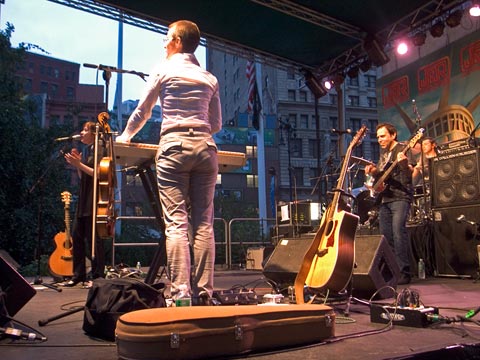
Suzanne Vega and band (Mike Visceglia on bass) in City Hall Park
I was particularly impressed with Zephyr and Angel's Doorway, which benefit from the dirt and noise of live performance. Many of the new songs are placed in New York City, and touch on, or directly evoke the continuing presence of 9/11. And here we were, last night, one block away from ground zero. The flood lights of the site filled the sky beyond the stage where just a few days ago a fire in the partially deconstructed Deutsche Bank building killed two (more) firefighters.
Suzanne ended her performance with the hits Luka and Tom's Diner. I am forever connected to Tom's Diner–as some of you may know–and every time I hear it, I find myself momentarily awash in images and memories of all that has occurred since I came to this city in 1977.
Here's a video about the origin of Tom's Diner.
Thursday, August 23, 2007
New York/Lab

Civil War test prints
Spent most of yesterday and today in the lab working on my Civil War monuments and statues. Made 15 prints, one panorama eight feet long. Basically, I bring in my color corrected and cleaned up digital files on a portable hard drive. I load those onto the computer at the lab, and then start with a series of test prints. From there, the full sizes are printed. Inevitably, the prints aren't exactly like the images on the monitor, so I adjust the files to get the results I want. The great thing about working here (Color Space Imaging) is that I can be in charge of the whole process from scanning to printing.
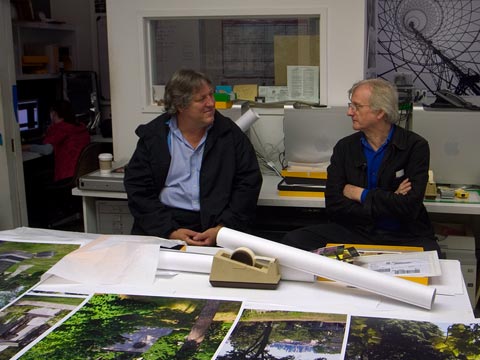 Art Presson and Richard Pare at the lab
Art Presson and Richard Pare at the labAlso printing today was Richard Pare who currently has an exhibition at MoMA of his photographs of early modern architecture in the former Soviet Union. Art Presson, who is putting together the Civil War exhibit at the Brooklyn Public Library came by to pick up the prints. I think he and I are both pretty happy with the images and the prints.
Tuesday, August 21, 2007
New York/New York Times Building
 New York Times Building (4x5 film)
New York Times Building (4x5 film)I know this is the third time I've posted a similar picture of the New York Times building by Renzo Piano, but this is the 4x5 version.
How it was done–for those interested in such things. I had access to an office window in the McGraw-Hill building on 42nd Street, which provides an unobstructed view of the NYT building over the roof of the Port Authority bus terminal. For the moment, the NYT sits relatively open. But to the left you can see foundation work proceeding for another skyscraper at the corner of 42nd Street and 8th Avenue. The Port Authority, itself, plans on building a tower above the bus terminal. So, in a few years, this view will be drastically changed, if not obliterated.
The McGraw-Hill, one of the glories of the Deco era (Raymond Hood, architect), still has operable windows, a rarity these days. The first image here on my journal was taken with a digital camera through the glass, which was ok, but I really wanted to come back and shoot with the view camera with the window open. Unfortunately, the windows are set so that they open only a couple of feet above a wide sill. Getting the 4x5 camera into that opening would be difficult, but I figured I could do it.
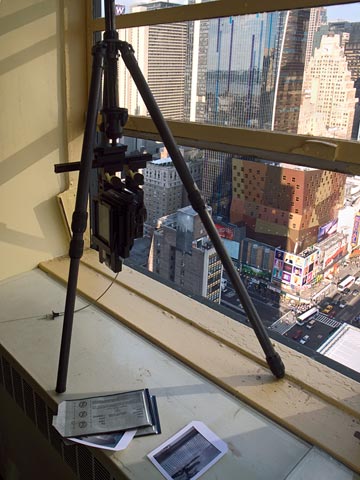
Upside down view camera
I got to my window on a beautiful late afternoon and began setting up the camera. Because of the tripod center post, I couldn't mount the view camera low enough for a clear view through the window. I was using a rather wide lens, so it was necessary to be as close to the opening of the window as possible. After fussing with the equipment for a while, I remembered something I'd done years ago, which was to flip the camera to the underside of the tripod and shoot through the legs. That's what I did, as you can see above. The camera, for those curious, is an ArcaSwiss Discovery with a small front element and lens board. A Schneider 65mm Super Angulon lens for this shot.
I am still using 4x5 film, and then scanning to digital files. I am also still using Polaroid film to preview what I'm doing, although when shooting out in the field, I use this alarmingly expensive film sparingly. Is it worth it continuing to shoot film? I think so–for now. Today, I go to the darkroom to make 4x5 foot prints of the Civil War/Brooklyn project from high resolution scans of 4x5 film.
Friday, August 17, 2007
Wednesday, August 15, 2007
New York/Brooklyn
I have finally finished shooting for the Civil War project, which I've written about previously. The last images were not of generals or memorials to the dead, but pictures of Abraham Lincoln and Henry Ward Beecher, two of the most important people in American history.
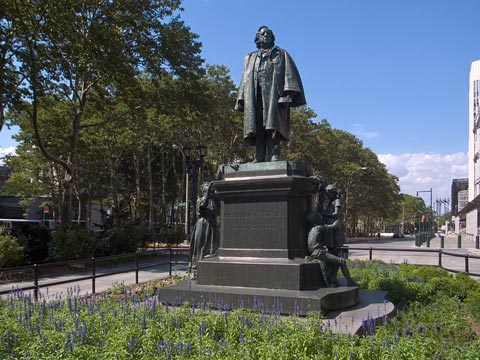
Henry Ward Beecher, Columbus Park, downtown Brooklyn
sculptor: John Quincy Adams Ward (1830–1910)
Beecher, obviously, is the lesser known of the two, but he was a preacher of enormous influence who used the pulpit to loudly advocate the abolition of slavery and the right to vote for women. His sister Harriet Beecher Stowe was the author of Uncle Tom's Cabin, the best selling novel of the 19th century, a book that had a tremendous impact on public opinion leading up to the Civil War. There is a recent Beecher biography–which I have not yet read–by Debby Applegate called The Most Famous Man in America. Here is a review in the New York Times.
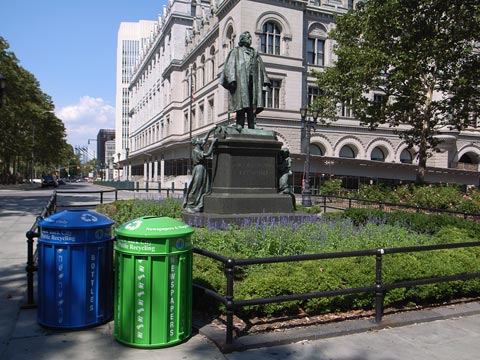
Henry Ward Beecher and recycling containers
The statue of Beecher is imposing, two children on one side, an African American woman on the other. It benefits from an important location in Columbus Park adjacent to the courts and Brooklyn's Borough Hall. Were Beecher alive today he might well be in favor of recycling, but the two containers standing beneath him are, perhaps, in the wrong place.
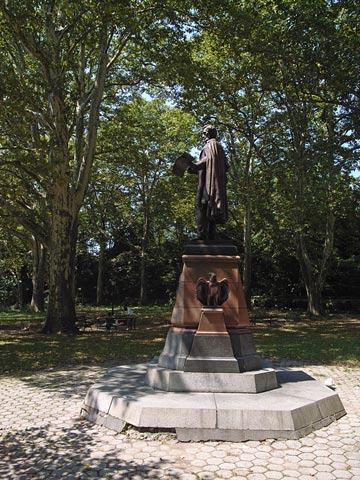
Abraham Lincoln, Concert Grove in Prospect Park
sculptor: Henry Kirke Brown (1814–1886)
Much less fortunate is the location of Abraham Lincoln in Prospect Park. The statue was originally in Grand Army Plaza, but it was moved when the ceremonial arch was constructed.
Lincoln can be found–with some difficulty–in Concert Grove, which has a number of significant busts of composers. Unfortunately, however, this part of the park has been marred by the addition of a skating rink and a nearby parking lot. Lincoln stands majestically holding a copy of the Emancipation Proclamation overlooking the rundown ice rink, abandoned during the summer.
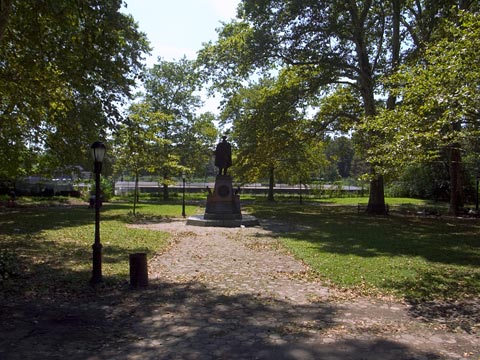
Abraham Lincoln
Abe deserves better than this.
I understand that there are plans to relocate the rink to the parking lot, and then restore the view of the lake. Perhaps, then, Lincoln will be properly honored.
From the Gowanus Lounge, a Brooklyn blog:
The current rink, which is more than 40 years old, has has long been a thorn in the side of Prospect Park purists. Created during the reign of Robert Moses, the rink replaced what had been Music Island, a small island with a stage facing the audiences in the park's Concert Grove. Its construction altered what is said to have been one of the park's most beautiful vistas.

Henry Ward Beecher, Columbus Park, downtown Brooklyn
sculptor: John Quincy Adams Ward (1830–1910)
Beecher, obviously, is the lesser known of the two, but he was a preacher of enormous influence who used the pulpit to loudly advocate the abolition of slavery and the right to vote for women. His sister Harriet Beecher Stowe was the author of Uncle Tom's Cabin, the best selling novel of the 19th century, a book that had a tremendous impact on public opinion leading up to the Civil War. There is a recent Beecher biography–which I have not yet read–by Debby Applegate called The Most Famous Man in America. Here is a review in the New York Times.

Henry Ward Beecher and recycling containers
The statue of Beecher is imposing, two children on one side, an African American woman on the other. It benefits from an important location in Columbus Park adjacent to the courts and Brooklyn's Borough Hall. Were Beecher alive today he might well be in favor of recycling, but the two containers standing beneath him are, perhaps, in the wrong place.

Abraham Lincoln, Concert Grove in Prospect Park
sculptor: Henry Kirke Brown (1814–1886)
Much less fortunate is the location of Abraham Lincoln in Prospect Park. The statue was originally in Grand Army Plaza, but it was moved when the ceremonial arch was constructed.
Lincoln can be found–with some difficulty–in Concert Grove, which has a number of significant busts of composers. Unfortunately, however, this part of the park has been marred by the addition of a skating rink and a nearby parking lot. Lincoln stands majestically holding a copy of the Emancipation Proclamation overlooking the rundown ice rink, abandoned during the summer.

Abraham Lincoln
Abe deserves better than this.
I understand that there are plans to relocate the rink to the parking lot, and then restore the view of the lake. Perhaps, then, Lincoln will be properly honored.
From the Gowanus Lounge, a Brooklyn blog:
The current rink, which is more than 40 years old, has has long been a thorn in the side of Prospect Park purists. Created during the reign of Robert Moses, the rink replaced what had been Music Island, a small island with a stage facing the audiences in the park's Concert Grove. Its construction altered what is said to have been one of the park's most beautiful vistas.
Tuesday, August 14, 2007
New York/McGraw-Hill Building
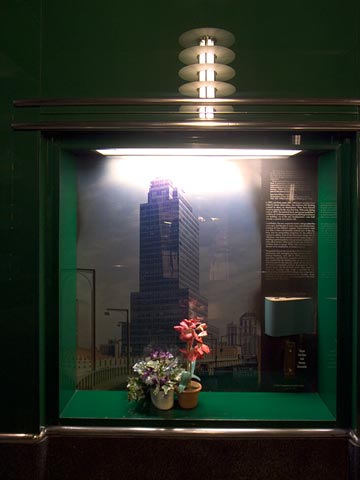
McGraw-Hill Building
One of he great art deco buildings in New York, designed by Raymond Hood. The lobby has retro-modern fluorescent lighting fixtures. Not very pleasant light, but very cool in a Jetson's sort of way. The building is reasonably maintained, but not in the manner of Rockefeller Center or other top Manhattan office towers. It's rather intense on 42nd next to the Port Authority bus terminal and Times Square, but the area is quite cleaned up nowadays. The Port Authority has plans for a tower above the bus terminal, which will very likely overwhelm the McGraw-Hill. The photo shows one of the display cases in the lobby.
Monday, August 13, 2007
New York/Green-Wood Cemetery
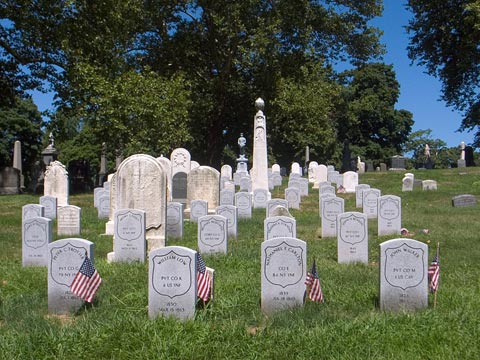 Soldiers' Lot
Soldiers' LotI have been photographing Civil War monuments around Brooklyn and in Green-Wood Cemetery for an upcoming exhibition at the Brooklyn Public Library. On Saturday I focused on several areas of the cemetery with special attention to the field of Civil War gravestones at the feet of Our Drummer Boy, a small sculpture of 12 year old Clarence MacKenzie who was Brooklyn's first fatality of the war. He was killed accidentally in camp by a stray bullet.
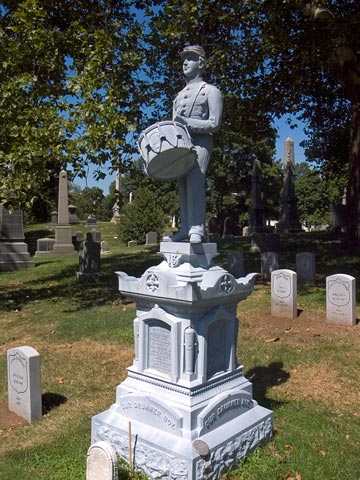
Our Drummer Boy
It's interesting to compare this sculpture to the 9/11 fireman a couple of posts earlier. Both attempt to dignify their subjects, but succumb to kitsch. Nevertheless, they are arresting images of youthful innocence cut down by powerful outside forces. As one surveys the hill of stones, it's Our Drummer Boy who stands out lending a face to a war of horrific slaughter.

Our Drummer Boy inscription
On the back of the plinth is the inscription: This young life was the first offering from King's County in the war of the rebellion.
I did quite a few photographs with the view camera of Our Drummer Boy and the surrounding Civil War stones, none exactly like the pictures above which were made with my digital camera. It was a rare and beautiful August day–crisp and clear, temperature in the '70s.
Sunday, August 12, 2007
New York/New York Times Building
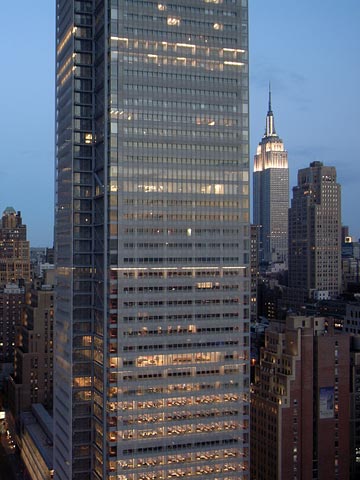
The New York Times Building and the Empire State Building
I've been very busy the past few days finishing up photographing Civil War monuments around Brooklyn and in Green-Wood Cemetery. I'll update things in a day or two.
For the moment, here's a new picture--same window vantage point as before--of the New York Times Building on 8th Avenue near Times Square. I did a series of photographs with the view camera. But this image was done with my digital camera.
Saturday, August 11, 2007
New York/Houston Street
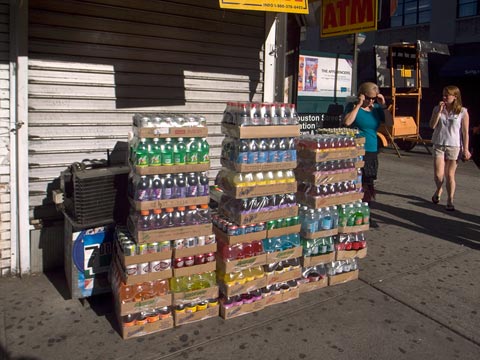
Houston Street and 7th Avenue, summer in New York
Went to see No End in Sight, a documentary about the Iraq war, at Film Forum on Houston Street. Most interesting to me is that Colin Powell's deputy, Richard Armitage, is talking. Will Powell ever speak out and attempt to salvage his reputation? Or soldier on into oblivion?
Thursday, August 09, 2007
New York/Green-Wood Cemetery

Main Gate, Green-Wood Cemetery (Richard Upjohn, architect)
Today, I continued working on a series of photographs of Civil War monuments in Brooklyn–specifically Green-Wood Cemetery. There are a number of memorials here of celebrated generals, but also many of the unsung who died on the battlefield. There are many other famous New Yorkers buried here as well. As I was setting up a shot of the Civil War Soldiers' Monument, I looked down and saw, at my feet, the grave of Leonard Bernstein, the conductor and composer.
Clouds moved in during the afternoon, and as I was packing up my camera I spotted a diminutive stone fireman surrounded by flags and flowers. The first line of the inscription read: On September 11, 2001, the rescuers at the World Trade Center not only saved over 25,000 lives – they saved America.
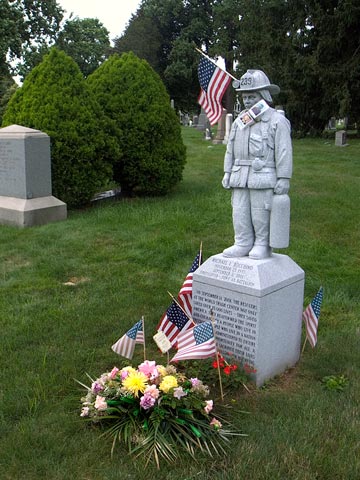
Green-Wood Cemetery
The fireman was depicted almost as a doll-like figure despite the detailed uniform and equipment. Less a hero, more a huggable object. It's a curious need, to fetishize these heroes of 9/11 who were doing their jobs. Who acted as heroes as they did every day when confronted by burning buildings or other dangers. I was struck, however, by the face of the real firefighter in the laminated photos hung around the statue's neck, his vitality a rebuke to the awkward carving and grandiose prose etched in stone.
Monday, August 06, 2007
Saturday, August 04, 2007
New York/One Chase Manhattan Plaza

One Chase Manhattan Plaza
I scouted a future photo shoot on a high floor of the Chase Manhattan Bank building (JPMorgan Chase), one of the first glass and steel buildings to go up in Lower Manhattan. The building, designed in large part by Gordon Bunshaft of Skidmore Owings Merrill (SOM), was something of a knockoff of Mies van der Rohe's Seagram building in Midtown. It even mimicked Mies' decorative i-beams affixed to the curtain wall. At the time it was begun–1957–the downtown skyline was a pyramidal collection of thin, spired, towers. Chase Manhattan's broad slab disturbed that harmonious composition.
I have to say, however, that Chase Manhattan today stands out as one of the most elegant of the International Style buildings. It is well maintained by JPMorgan Chase and it's silvery skin looks almost new. The raised plaza remains well used by passersby, and people stop constantly beneath the Dubuffet sculpture or look down into the circular Noguchi garden. What fails so often in other projects works here. The juxtaposition of the various elements of sculpture, garden, plaza, and tower form an abstract, but coherent, grouping. Most of SOMs tower/plaza buildings, such as those along Sixth Avenue, stand alone with too much space around them, giving them a supremely aloof air. The banal exterior articulation of the buildings doesn't help either. Chase Manhattan benefits from its tightly spaced setting, a modernist glass box ringed by deco and neo-gothic spires.
As I was leaving the building from a freight elevator on the lower level, I came across the original architect's model of the building. It's not in a location many are likely to see. I snapped a couple pictures, and was promptly chewed out by a guard. No pictures! But here it is above. A beautiful and important object of architectural history.
Thursday, August 02, 2007
New York/Bay Ridge
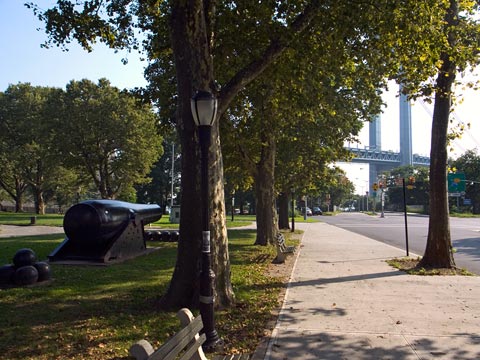
Rodman Gun and Verrazano Narrows Bridge, Bay Ridge, Brooklyn
Continuing work on a series of photographs of Civil War monuments and statues I took the R train to the end of the line. This is Bay Ridge, Brooklyn, a prosperous part of the city I'd never visited before. At the foot of 4th Avenue is John Paul Jones park adjacent to Fort Hamilton, a historic army base. In the park is a surviving Rodman Gun, a massive cast iron cannon used to defend New York Harbor.

Rodman Gun
I was there for for almost two hours waiting for a stubborn ridge of clouds to slip by, and then had less than a half hour to catch the last slanting sunlight. I did a couple of pictures with the Verrazano Bridge in the background, a couple closeups of the cannon and cannonballs. A few dog walkers strolled by. Lots of bicyclists and joggers cruised by. A group of beer drinking homeless occupied a bench nearby. Some kids arrived and began climbing the cannon, but I had already packed up my 4x5 camera. I snapped a few shots with my digital camera. The whole excursion to Bay Ridge took more than five hours.
